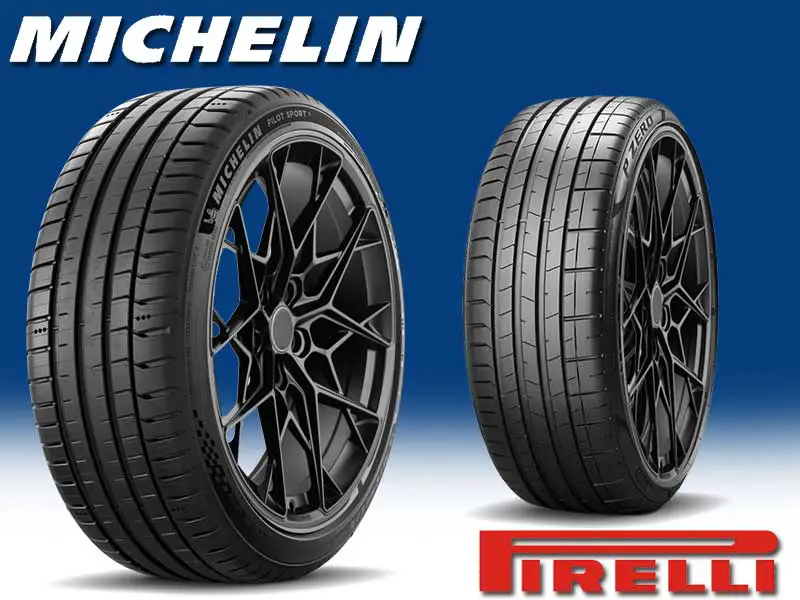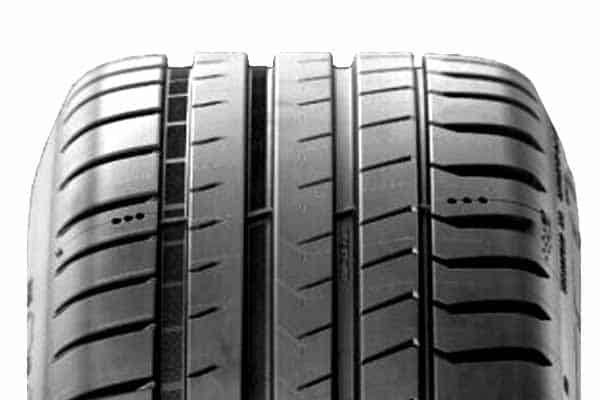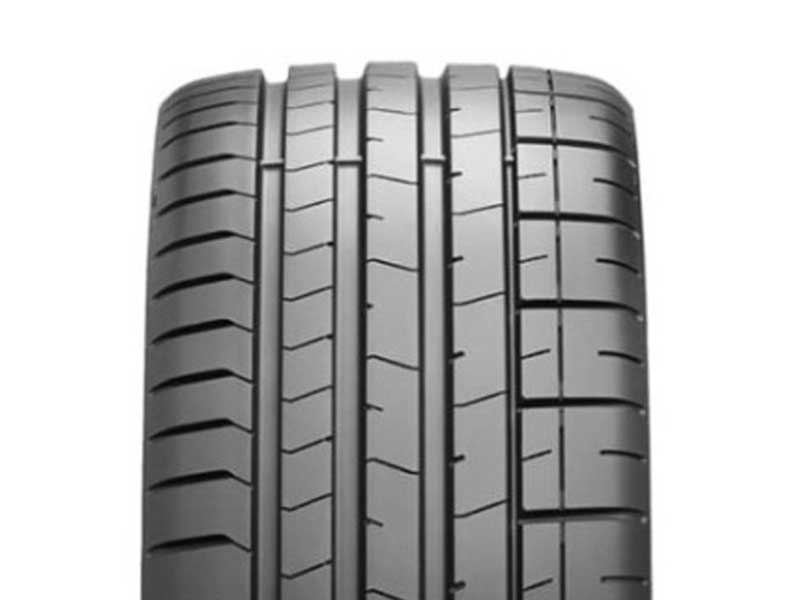Summer is the season of road trips, scenic drives, and high-speed adventures. It calls for tires that can keep up with the heat and the pace – enter the Michelin Pilot Sport 5 and the Michelin Primacy 4+. In this article, we’ll dissect these two top-notch summer tires, examining their features, performance, and overall value.
Now, before delving into their performance based on tread designs, let’s first get a clear understanding of their sizes and specifications.

| Specs | Michelin Pilot Sport 5 | Pirelli P Zero PZ4 |
|---|---|---|
| Sizes | 18 total sizes | Varies (18 to 24 inches rims) |
| Rim Sizes | 17 to 20 inches | 18 to 24 inches |
| Speed Ratings | Y only | W, Y, V |
| Load Ratings | XL only | SL and XL |
| Tread Depth | 9/32″ | 9/32″ |
| Weight Range | 17 to 34 lbs | 19 to 43 lbs |
| Tread Mileage Rating | 30k miles warranty | No warranty |
Table of Contents
Tread Design
The Michelin Pilot Sport 5 showcases a sophisticated asymmetric tread pattern, composed of five distinctive ribs that create four longitudinal grooves in total. Among these grooves, three maintain consistent widths, while the fourth takes on a narrower profile, as can be seen in the image below.

Each central rib is continuous running and is equipped with various slanted incisions, which can also be considered as sipes. These siping cuts differ in length across all ribs, with the shoulder lugs displaying the most substantial ones.
Though still with very subtle differences, each of its shoulder lugs (on both sides of the tread), feature unique characteristics. On one side, the lugs possess thicker slits that gradually narrow as they approach the slimmer longitudinal groove (on the right).
While towards other side, the shoulder voids are less aggressive, with a slightly more uniform looking pattern.
Moving towards the Pirelli P Zero PZ4, this tire also feature an symmetric tread design.

Just like the Pilot Sport 5, its tread design is also comprising of 3 central ribs, flanked by four longitudinal grooves.
And again, in a similar fashion, interestingly, these grooves display a mix of widths, where one is noticeably narrower (right side of the image above), than the other three, which share a uniform width.
All these ribs run continuously, I mean the lateral slits may seem to form “blocks”, they are not full depth.
Speaking of these slits, each of these ribs display a different pattern, where two of them closely matching each other, while the third rib (on the left side), show up with more number of these cuts/incisions.
Moving towards the shoulders, they differ a lot form one side to another.
On the right side (of the image), the lugs carry a much more aggressive pattern with a combination of lateral and longitudinal cuts, while on the other, the blocks have a more minimalist design.
Dry Traction
Dry performance is a two-fold attribute that consists of handling and grip. Let’s start with the later.
Directional Grip
Directional grip, is primarily determined by the central area of the tread. This is because it assesses how much contact the tire makes with the road surface, (while rolling straight).
The Pirelli PZ4 performs exceptionally well in this regard, offering shorter braking distances.
Its superior performance can be attributed to its thicker central ribs compared to those of its competitors, enhancing road contact and facilitating more efficient braking. However, it’s worth noting that the improvement is only by a minimal margin.
Handling
On the other hand, a tire’s handling is predominantly influenced by its shoulders. This is because, as a tire corners, the force of inertia causes its weight to shift towards the outer edges.
And so this results in the tire’s shoulders playing a pivotal role in maintaining control and stability, significantly affecting handling performance.
And in this aspect, the Pirelli PZ4 again, stands out due to its thicker shoulder lugs. With larger shoulder blocks on both sides, the tire is able to provide a larger footprint for road contact, enhancing handling.
Moreover, its stiffer rubber composition is also a contributing factor here. While the larger weight of the Pirelli P Zero doesn’t necessarily aid in flexibility, its stiffer rubber does. This restricts excessive lug bending, and allow for faster steering responsiveness, making the PZ4 a superior choice for handling.
Wet Performance
Wet traction is crucial for tire performance and consists of two primary components: wet grip and hydroplaning resistance.
Wet Grip
Wet grip primarily originates from the sipes present in the tire, which essentially generate additional biting edges and create transient storage spaces for water, thereby enabling the tire to sustain contact with the road.
Although summer tires, in comparison to all-season tires, generally fall short in providing a sufficient quantity of these sipes, the Michelin Pilot Sport 5 outperforms its competitors in this aspect.
Given that these sipes flex, expand, and contract, the Pilot Sport 5, with its relatively softer compound, presents more effective siping, efficiently clearing away water particles.
Moreover, the tire’s wet grip is also enhanced due to its outstanding hydroplaning resistance, see below.
Hydroplaning
In simple terms, hydroplaning happens when a tire loses contact with the road and starting hovering over watery surface (due to thin layer of water formation between the tread and the road).
Needless to say, this issue arises when the tire’s grooves are unable to effectively channel water away in time, mainly because of higher speeds.
Having said that, out of both tires, the Michelin Pilot Sport 5 reaches greater (float) speeds in both curved and straight running tests, rendering it better.
Its superior performance can be attributed to a 2 key features.
Firstly, the tire has larger tread voids, which allow for a more rapid water evacuation.
And secondly, the tire’s tread compound contains a marginally higher amount of silica, which produces a stronger negative pressure, enabling water to gush out more quickly.
Moreover, as the tire gets to throw water out more effectively, it’s sipes also have to work less, so indirectly that also helps with the gripping part.
Fuel Economy
Fuel efficiency and rolling resistance are directly correlated with one another, by some additional factors such as weight and tread composition.
And considering them, it makes sense why the Pirelli P Zero PZ4, gets to consume more fuel, comparatively.
The tire basically lacks in providing as much of a streamlined structure as its counterpart, and it’s relatively more flexible tread compound, leads to its lugs being more susceptible to bending (as the tire turns, brakes or corners, for example).
And of course, this leads to extra energy expenditure.
Moreover, the PZ4, is also heavier, so its lugs are rubbed against the road, with relatively greater pressing force, increasing overall rolling resistance values, and in return negatively affecting fuel usage.
Tread Life
Tread life is largely influenced by the tread composition, overall construction, and rolling resistance of the tire.
And looking at these factors, it’s understandable why the Pilot Sport 5 performs better in this aspect.
The tire’s stiffer compound doesn’t wear off as quickly, and its lighter structure exerts less force on its lugs against the road, minimizing wear.
So it makes sense that the Pilot Sport 5 offers a warranty for 30,000 miles, while the Pirelli PZ4 doesn’t offer any.
Road Comfort and Noise Levels
Airflow is one of the main factors, which significantly contributes to the overall noise generation by a tire.
Air basically flow through the tread voids, and hit the walls around. And this impact is what causes noise.
Having said that its logical to see Pirelli Pz4 providing you with a quieter option, with its relatively more compact tread voids.
The Pilot Sport 5 on the other hand, although does great in hydroplaning resistance, with its wider channels, they also get to produce more tread noise comparatively.
Moreover, the tire’s stiffer rubber compound is also not so great when it comes to impact comfort performance as well.
Whereas on Pirelli PZ4, the greater number of sipes allow for better lugs maneuverability, so bumps of the road are dampened down in a better way.
Conclusion
Lets summarize all we have discussed here so far, by considering different sections.
- In terms of dry performance, the Pirelli PZ4 excels in grip and handling due to its thicker central ribs and shoulder lugs, combined with its stiffer rubber composition.
- In wet environments, the Michelin Pilot Sport 5 outshines its peer, with its effective siping and higher silica content, aiding in superior grip and hydroplaning resistance.
- In terms of fuel, the Pirelli is lacking due to its less streamlined structure and greater weight.
- And in terms of treadwear, Pilot Sport 5 offers better (tread life), due to its stiffer compound and lighter structure.
- And overall the Pirelli PZ4 is more comfortable tire.